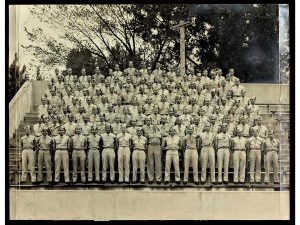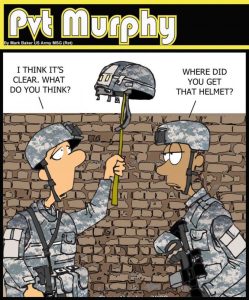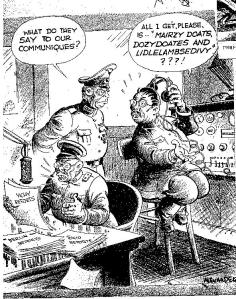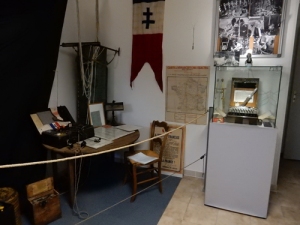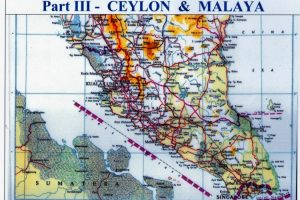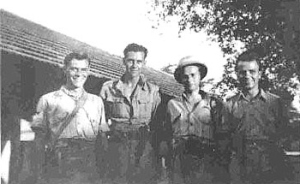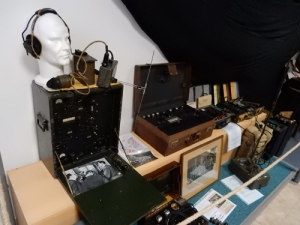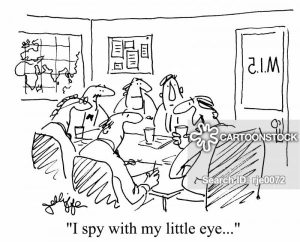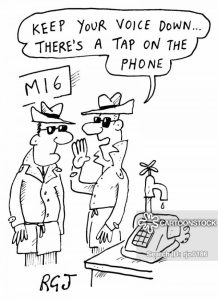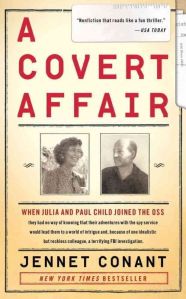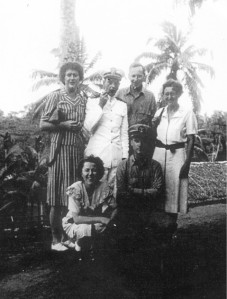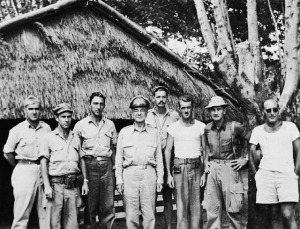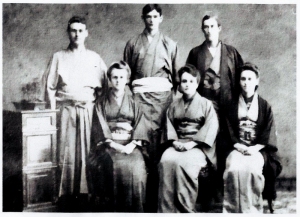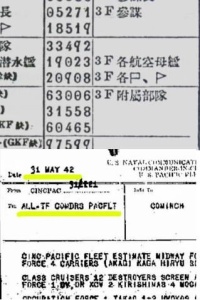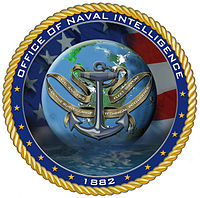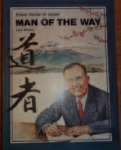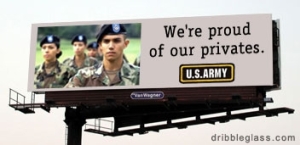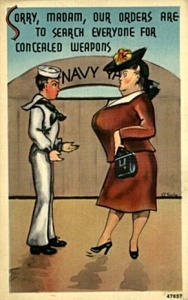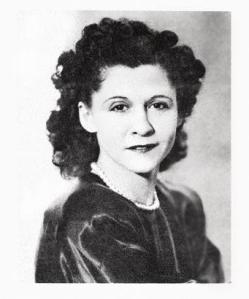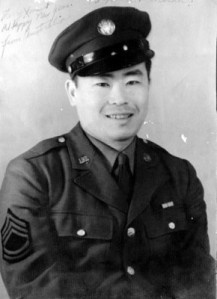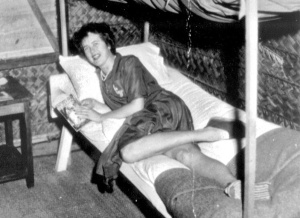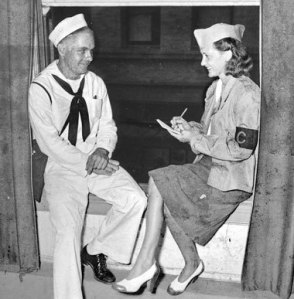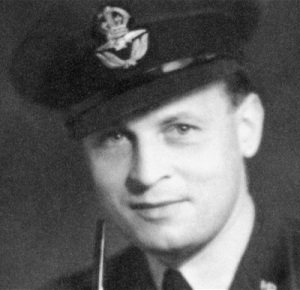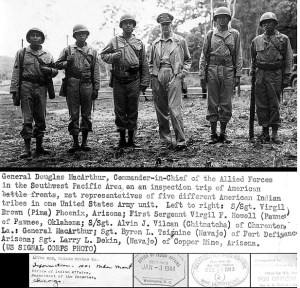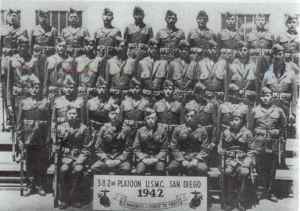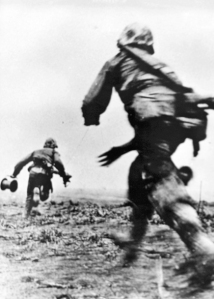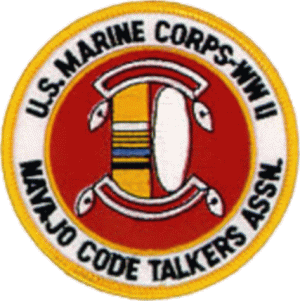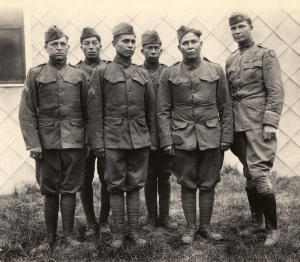Blog Archives
MIS Interpreters
Throughout the war, more than 6,000 Japanese Americans would serve in the MIS as translators and interrogators—often at great risk—for 130 units across the Pacific. After the war the MIS Nisei were tapped for critical assignments during the occupation of Japan.
The Military Intelligence Service (MIS) consisted mainly of Nisei men, for further information on the Japanese-Americans who served, I have a series on them, that can be located HERE>
Nisei interpreters worked closely with American and Japanese officials to recover the war-torn nation and restore a peacetime government. They also worked as translators during war crimes trials held in Japan, China, the Philippines, French Indochina and the East Indies.
One of the most valuable contributions of the Nisei in the MIS was the translation of the captured documents referred to as the “Z Plan,” which outlined the Japanese plans for counterattack in the Southwest Pacific in 1944.
By the war’s end Nisei linguists had translated an astounding 20.5 million pages of documents. Without a doubt, the intelligence gathered by MIS interpreters shortened the war and saved lives. The work that many Japanese Americans performed with the MIS extended beyond World War II into the Cold War years, including occupation duty. Nisei often served as a bridge between occupation authorities and civilians. This service often continued through the Korean War and into the Vietnam era.
During war crimes trials in the Pacific, Nisei translators and interpreters monitored translations, both English and Japanese, performed by Japanese interpreters. They listened for accuracy and possible corrections, ensuring a correct translation for the court records.
The postwar contribution of the MIS included women; Nisei volunteers with the Women’s Army Corps [WAC] were trained in translation of military documents for occupation duty. Until the early 1970s many of the contributions of the MIS were classified, and the stories and service of Nisei linguists went unrecognized.
The first recognition of MIS veterans came with the Presidential Unit Citation awarded in 2000 by President George W. Bush. In 2010, MIS veterans received the Congressional Gold Medal along with the other Japanese American veterans of the 442nd Regimental Combat Team and the 100th Infantry Battalion.
Koso Kanemoto in Japan
Fellow blogger, Koji Kanemoto speaks of his father’s, Koso Kanemoto’s, MIS duty in his posts….
“There’s No Toilet Paper in the Jungle of Burma”
WWII Military Intelligence Today
################################################################################################################
Military Humor –
################################################################################################################
Farewell Salutes –
Gerald Anderson – Coffee Springs, AL; US Air Force, Vietnam
Charles Bringe – Melrose, MN; US Navy, WWII, gunner / Korea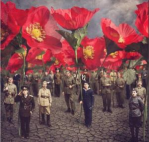
William Cook – Covelo, CA; US Army, Korea, Lt.
Gertrude Drummond – Glen Cove, NY; Civilian, WWII, Grumman Aircraft
Juan Jaurigue – Tucson, AZ; USMC, WWII, PTO, 3 Purple Hearts, Bronze Star
Wilbur F. Kohlmorgan (101) – Montrose, IA; US Army, WWII, ETO, 34th ‘Red Bull’ Division
Pauline Lagarde – New Orleans, LA; Civilian, WWII, Pentagon
Chester ‘Glen’ Norton – Mt. Eerie, IL; US Navy, WWII, gunner
Irving A. Troob – Providence, RI; US Army, WWII, Middle East & CBI, Technician, 96th Signal Battalion
Lionel Woods (100) – Alexandra, NZ; Royal Navy, WWII, # MX70124
######################################################################################################################################################
Ceylon and the SOE
The Special Operations Executive (SOE) resulted from bringing together the UK’s three secret services for the duration of the War in order to conduct espionage, sabotage and reconnaissance. Ceylon was initially a base for SOE personnel operating in South East Asia with headquarters in Kandy and a training facility at the Mount Lavinia Hotel. Operatives were inserted into Japanese occupied South East Asia via submarine.
When SEAC moved from Delhi to Kandy so did SOE Force 136 under Head of Mission Colin Mackenzie CMG. According to Ashley Jackson, writing in The British Empire and the Second World War, “Ceylon had been transformed strategically from a relative backwater, a mere operations sub-branch of the India Mission, into Force 136’s main base.”
Capt Freddie Chapman had trained Australian and New Zealand troops in guerrilla warfare at the Special Training School 101 in Singapore. They would remain in Malaya during Japanese occupation to harass the enemy as part of Force 136. Capt Chapman had already forged an alliance with the Malayan Communist Party (MCP) composed of anti-Japanese Chinese. They were armed by the British and instructed to take to the jungles in order to continue the war against the Japanese. The MCP led by the legendry Chin Peng was highly disciplined and were fed, supported and given shelter by local Chinese.
In early 1945 Capt Chapman was brought out to Kandy to arrange for weapons and equipment for his guerrilla fighters about half being Britons who had worked or lived in Malaya before the war, the rest Chinese. “Air supplies from Ceylon supported the 3,500 Malayans trained to harass the Japanese when the British mounted their amphibious assault late in the war. Liberators of No. 357 Squadron from Minneriya in Ceylon, for example, flew 249 sorties in June and July 1945 in support of forces in Malaya,” explains Prof Jackson.
In late 1944 Gen Roger Blaizot commander of the Forces Francaises Extrême Orient (the Far East French Expeditionary Forces) arrived in Ceylon along with French troops to establish a Free French Military Mission to the Far East. Gen Blaizot and his troops were inserted into French Indochina where they operated till the end of the War. According to Jackson “Ceylon also became an important (signals) intelligence-gathering outpost of Bletchley Park (the future Government Communications Headquarters [GCHQ]) and a regional headquarters for Special Operations Executive.”
In Operation Bunkum launched from Ceylon, agents were ferried by submarine to the Andaman Islands to report back on Japanese forces, a clandestine mission which they carried out successfully maintaining radio contact with Calcutta. In another operation, a group of Thais living in the UK volunteered for a mission for which they boarded the submarine HMS Tactician to be dropped off on the Thai coast. Britain’s Secret Intelligence Service (MI6) also trained Thai agents at SEAC who were ferried by HMS Tactician to carry out assaults in Phuket and Penang.
In collaboration with the Dutch and operating out of bases in Ceylon, RAF Liberators parachuted agents into Sumatra. And the US Office of Strategic Services (the predecessor of the Central Intelligence Agency) also operated out of Ceylon with headquarters in Kandy, training camps in Galle and Trincomalee and a supply depot in Colombo. “RAF Special Duties squadrons, usually flying long-range Liberators, were used to parachute agents and supplies into occupied territory, and most sorties were flown from Ceylon bases,” writes Jackson.
While combat experience in Ceylon was limited, the CDF benefited from training with British and Allied units rotated through Sri Lanka, especially for jungle warfare in South East Asia. Individual officers and soldiers of the CDF also had combat experience in other theaters.
In addition to service in the Cocos Islands, members of the CDF also volunteered for active duty in Burma. Writing in his Sunday Times article Forgotten campaign, forgotten veterans Sergei De Silva Ranasinghe says Brian Kirkenbeek was commissioned 2nd Lieutenant with the 2nd Battalion CLI in 1942. In January 1944 he was posted to D Company 4/5th Gurkha Rifles at Arakan where he saw action. On his return to Ceylon he was promoted and rejoined the CLI at China Bay. Ranasinghe goes on to say that some volunteered for service in Europe and experienced combat in that theater.
Three new units of the CDF were raised during the War, the Ceylon Signal Corp and the Auxiliary Territorial Service in 1943, and the Royal Military Police (Ceylon) in 1944. At the end of the war the CDF which comprised 645 officers and 14,247 other ranks was demobilized. Col R.J.F. Mendis OBE ED was appointed Commander of the CDF in April 1946 and Lt Col Anton M. Muttukumaru became commander of the CLI which reverted to its peacetime strength.
The British noted that the Ceylonese Board of Ministers did everything within their power to maximize the island’s contribution to the war effort. They channeled personnel and material resources in support of the war effort.
The only exception being the Lanka Sama Samaja Party which opposed the War and whose leaders were incarcerated or went underground for the duration of the War. However the civilian ministers wholeheartedly supported the war effort and there was total cooperation from the Island’s political, civil and military leadership.
In 1948 this political relationship resulted in Ceylon acquiring Dominion Status within months of India. Prof Ashley Jackson in The British Empire and the Second World War concludes that “this was a result of pressure from senior British military and civilian officials in Ceylon in favor of a significant advance towards full self-government.”
###############################################################################################################
British Military Humor –
################################################################################################################
Farewell Salutes –
Keigan Baker – Panama City, FL; US Air Force, Airman 1st Class, 24th Special Operations Wing, KIA
Michael Canonico – Chester, NY; US Army Air Corps, WWII, PTO, Co. A/188/11th Airborne Division
Fletcher Derrick – Mt. Pleasant, SC; US Army, Medical Corps, 8th Artillery Div., surgeon / Army Intelligence, Order of the Palmetto (Ret.)
Fred Goodson – Gastonia, NC; US Army Air Corps, WWII, ETO, 508/82nd A/B Division / USAR, Colonel (Ret. 39 y.)
Nancy Hookham – Eastbourne, ENG; British Navy WREN; WWII, Bletchley Park
Jesse Irvin (99) – Coushatta, LA; US Army, WWII
Harold Little – Watertown, NY; US Army Air Corps, WWII
Elsie McCurry – Texarkana, AR; Civilian, aircraft manufacture and repair
Carolyn J. Protzmann – Franklin, NH; US Air Force / US National Guard, BGeneral (Ret.)
Clarence Rutherford – Augusta, KS; US Army Air Corps, CBI, WWII
################################################################################################################################################################################################################################
OSS in the C.B.I. – 1945
In the book, “A COVERT AFFAIR”, Jennet Conant follows the OSS detachments that operated in the CBI Theater. These members of the forerunner of the CIA included Elizabeth (Betty) MacDonald, her future husband Frederick MacIntosh, Julia McWilliams and her future husband Paul Child, and many others.
From time to time, the OSS teams would report armed clashes in the area (China) as local factions jockeyed for position, “The warlords were always shooting at each other,” recalled Betty, “But we never really felt scared. We had pretty good protection, and the Flying Tigers kept the Japanese at bay.”
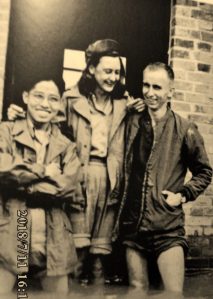
Betty MacDonald w/ colleagues in the doorway of the flooded MO print shop during the 1945 flood in Kumming. The fortified walls around the outpost made the OSS compound a lagoon.
Betty also reported, “the Chinese never followed the rules. Smuggling was a way of life. They brazenly peddle state secrets and are equally overt about trading everything from information to arms with the Japanese. Everything is for sale.”
Chiang’s people had to approve any proposed OSS operation. Paul Child said, “The warp and woof of war in China is complex beyond belief. The inner workings, the who-influences-who, the deals, the sleights of hand, the incredible chicaneries, the artistic venalities, the machinations and the briberies.
“Some facts are so incredibly romantic and sinister that only hearing hundreds of verbal reports from the mouths of horses themselves finally convinces me of the dreadful reality of the under-the-sea war – the war of back alleys, back rooms, big parties, magnificent whores and equally magnificent blackmails. It almost becomes the “real” war of which the news-war is only the surface expression.”
The chances for honest-to-God peace in China seemed almost impossible. Even with the European part of the war officially over, the action in the CBI seemed to be amplifying. Paul Child wrote home to his twin brother Charles in dismay, “Building up, plans for months ahead, materials and personnel being striven for and allocated, and anticipated dangers faced. Perhaps you will never know what it is to feel profoundly lonely. Well, you become empty, unbased and bereft.”
Click on images to enlarge.
#############################################################################################
Military Humor –
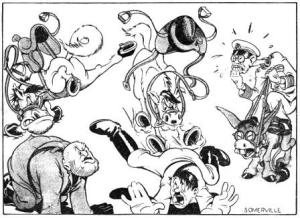
Roundup’s staff cartoonist, Sgt. Ralph J. Somerville, was so overjoyed on V-E Day that he sat right down and drew up this cartoon of the situation in which Mussolini, Hitler, and Hirohito find themselves. Of course, as nay fool can plainly see, there isn’t but one title for this: Two off their War Horses and One on His Ass.
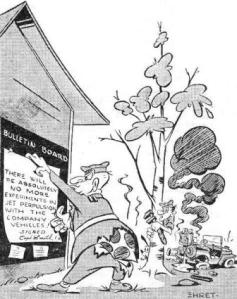
Bulletin Board: “There will be absolutely no more experiments in jet propulsion with company vehicles!”
#############################################################################################
Farewell Salutes –
Elmer Brown – Orlando, FL; US Navy, WWII, Lt.Commander (Ret. 30 y.)
Arthur Kelm-Gelien (Tab Hunter) – San Francisco, CA; US Coast Guard, (actor)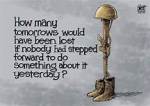
Saman Kunan – Roi Et, THAI; Thai Navy SEAL, Cave rescue
Cidon Long – Anson, TX; US Army, WWII, homefront German POW guard
Joseph Maciel – South Gate, CA; US Army, Afghanistan, Cpl., 1/28/3rd Infantry Division, Bronze Star, Purple Heart, KIA
Helen Miller – St. Paul, MN; US Army WAC, WWII, ETO
George Ritter – Toledo, OH; US Army Air Corps, WWII, PTO, 11th Airborne Division
Robert Sutcliffe – Lynbrook, NY; US Navy, WWII
Deisel Tykeson – Ross, ND; US Army, WWII, PTO
Harrison Ward – Lenoir, NC; US Army, WWII, Bronze Star
#############################################################################################
PERSONAL NOTE: My internet was cut-off this morning, hence the late post and lack of visits to your sites. I will make every attempt this afternoon to correct this. I thank you in advance for your patience.
#############################################################################################
Intelligence
The Japanese altered their pre-war message codes after the Coral Sea (6 May 1942), and a few weeks before the Aleutians and Midway ( June 1942). The changes were enough to send US Naval Intelligence in Honolulu scrambling.
The Secret Service brought in a well-known Southern Baptist missionary who had recently arrived in Hawaii after being booted out of Japan along with the other undesirable westerners. Reverend Edwin Burke Dozier, who became part of the Olivet Baptist Church in Honolulu, was the son of S.B.C. missionaries from Georgia. He had been born and raised in Japan – the Nagasaki-Fukuoka area of Kyushu’s west coast.
Rev. Dozier’s masterful ear for the Japanese language discerned that the enemy was using Japanese baby-talk in the key parts of their altered code. These were not words found in any dictionary and a person would have had to been raised from birth in a Japanese home to know them.
Dozier helped to break the new code, and later, he was called upon frequently to evaluate O.N.I. reports and guide the code breakers in nuances in Japanese thought that steered their code formations. All the data was then sent on to Washington D.C.
On numerous occasions through and after the war he was offered high commissions in both the military and governmental intelligence services; all of which he refused. Dozier believed his calling in life was to preach the Gospel to the Japanese people.
When G-2 BGeneral Henry Muller Jr. was informed about these developments from Matt Underwood, Editor of “The Voice of the Angels” 11th A/B Division Assn., he was fascinated. Muller considered it to be no real surprise that an enemy as formidable and resourceful as the Japanese could come up with their own version of Navajo codetalkers by speaking a sort of language not found in any dictionary.
Rev. Dozier’s account is mentioned in his biography, “Edwin Dozier of Japan: Man of the Way,” by Lois Whaley, Women’s Missionary Union, 1983. This data was published in the “Voice of the Angels,” 11th A/B Div. Assn., Vol. 185, December 2014.
Judy Hardy at – Greatest Generation Lessons and I are attempting to coordinate our websites. As I post about June 1942 and the activity in the Aleutian Islands, she will be posting letters and home front stories that correspond. Judy had her Uncle Ced in Alaska at this time along with a family friend, Rusty.
##############################################################################
Military Humor – what have they been saying?
#############################################################################
Farewell Salutes –
Anthony Angerosa – Fishkill, NY; US Army, WWII, ETO, Purple Heart, Bronze Star
Turi Blake – Taranaki, NZ; RNZ Navy # 621648, WWII
Gunther Ditzel – Carlsbad, CA; US Army Air Corps, WWII
William Fay Jr. – Delray Beach, FL; US Navy, WWII, pilot
Donald Huard – Augusta, ME; US Army, WWII, PTO, 161st Infantry Reg/25th Infantry Div.
Harry Karas Jr. – Yakima, WA; US Army, Navy & Air Force, Korea, Vietnam, (Ret. 30 Years)
J.W. Landry Jr. – Crowley, LA; US Army, WWII, ETO, Bronze Star
Virginia Powers – Lansing, MI; USMC, Sgt. (Ret.)
Daniel Quinlin – Columbus, GA; US Army, Colonel (Ret. 33 years)
Raymond Sinclair – UK & CAN; British Army, WWII, ETO
Stella Uhorczuk – Alexandria, VA; WIMSA (USMC), WWII, (Ret. 30 years government service)
###############################################################################
ALLIED spies & saboteurs
There is no way for me to include all the information for every spy and/or saboteur of WWII for two reasons – there were far too many and because they did their job and stayed top-secret. An example of this would be the French Resistance and the BCRA, made up of British, French and Cajun-American volunteers. But some, due to the fact that they became famous or their work finally de-classified, I have included here as a matter of interest.
Claire Phillips, aka Dorothy Clara Fuentes, aka Claire Fuentes, aka Madame Tsubaki was also known as “High Pockets” and the “American Mata Hari.” She operated a nightclub in Manila and used he cunning ways to extract data from the Japanese officers that frequented her establishment. The agent then sent her intel directly to Gen. MacArthur or the U.S. Navy. Claire managed to deliver food and other necessary items to Allied POWs and had an underground of Filipino guerrilla to assist her. Mrs. Fuentes was eventually caught, put on trial and sentenced to die, but this verdict was never carried out. She was liberated on 10 February 1945 and returned to the U.S. The movie, I Was an American Spy was based on her life.
Richard Sakakida was inadvertently included in Gen. Yamashita’s army when he moved east and was assigned to Japanese intelligence on Luzon. He gained the trust of the Imperial Army in Manila and gave what data he discovered to the Filipino ROTC Group of guerrillas until they were captured. Sakakida then began forging release papers to get some of the members out of prison. He was never suspected, but later slipped away from his post and hid out in northern Luzon for months. Although he had received medals for his work from the government, his actual loyalty was brought into question in later years.
Army Chief Warrant Officer, Arthur Komori, was an agent as part of the Counter Intelligence Corps. He enlisted with Richard Sakakida in Hawaii at the start of the war. He allowed himself to be captured and placed in a Japanese interment camp in the Philippines until he was ordered to escape by Gen. Wainwright 16 April 1942.
Julia McWilliams Child would gain fame as a chef and t.v. personality, but she performed far different duties during WWII. When the war began, she wanted to join the WACS or Waves, but was rejected due to her height of 6’2″. Instead, Julia became part of the OSS (forerunner of the CIA) and as one of her projects, she helped to develop a shark repellent for downed pilots and crews. Later on, she supervised an OSS facility in China where she dealt with top-secret documents and in Ceylon. Her life as a WWII agent was documented in the book, A Covert Affair: Julia Child and Paul Child in the OSS.
Marlene Dietrich, better known for her work as an actress, was German born. She joined the OSS where she entertained the troops and then secretly broadcast propaganda to the weary enemy soldiers. She received the Medal of Freedom for her operations.
Elizabeth McIntosh was a war correspondent that began working with the OSS directly after Pear Harbor. While stationed in India, she intercepted and rewrote Japanese postcards being sent home. She also found an Imperial Order that discussed surrender terms and many other documents.
The OSS did most of its work in Europe and in Detachment 101 of the Burma-India-China Theater, where they trained Chinese soldiers to fight the Japanese and supplied target information to Gen. Chennault, the creator of the famous ‘Flying Tigers’ besides their regular duties. Both MacArthur and Nimitz refused their service and used their own intelligence units, but much of the OSS data was relayed to them via Washington. Allen Dulles was station chief of the OSS (his I.D. card is pictured at the top of the post) and looked and dressed like a middle-aged college professor. A lawyer by trade, he worked for the State Department during WWI. He collected intelligence with a complex espionage network. Dulles recruited Mary Bancroft, daughter to the publisher of “The Wall Street Journal” to analyze German newspapers, but she quickly became an agent in the cloak-and-dagger fashion.
Hans Bernd Gisevius, code name “Dr. Bernhard,” was an agent of the Alwehr, the German secret service (SS). In 1939, he became part of Schwarze Kapelle (the Black Orchestra), the group formed to kill Hitler. He contacted Dulles in 1943 and Mary Bancroft became his contact.
One group, barely spoken of, was the SOA (or Z Special Unit, as it is known today), the Special Operations of Australia. Many were barely 18 years old when they were recruited and trained to infiltrate the Japanese lines. They were formed by a group of British covert executives operating in Malaya in mid-1943; even the Australian Army was unaware of this unit’s existence. Over the 3 remaining years of the war, over 1,000 men were taught parachuting, explosives and espionage on Fraser Island. After their training, most were dropped on Borneo and other islands in S.E. Asia; over 100 were killed in combat. They even carried the infamous cyanide tablets. They were honor-bound by the Secrecy Act for 30 years to never speak of their activities; even as the other WWII soldiers were celebrated on ANZAC Day. Twenty-one remaining SOA men held their first reunion in 2010 on the island where they were trained.
The British spy who went by the code names, “Seahorse” and “Shelley” was the actual agent that inspired Ian Fleming to write his 007 series of books. Wing Commander Forest Frederick “Tommy” Yeo-Thomas was known to the German Gestapo as “The White Rabbit” and operated out of Vichy, France. An excellent accounting of his story is at http://en.wikipedia.org/wiki/F._F._E._Yeo-Thomas
The most unsuspecting man (in my opinion) to become a spy – was already dead. Early 1943, Allied forces, planning their invasion, needed to convince the enemy that their landing site was somewhere else. “Operation Mincemeat” originally came from Ian Fleming. A Welsh laborer, already deceased after ingesting rat poison, had his pockets filled with false papers and left where the Germans could find him. The operation proved very successful.
#######################################################################################
Farewell Salutes –
Paul Adams – Nebraska & Greenville, S.C.; U.S. Army WWII, Tuskegee Airman, 332nd Fighter Group
Pauline V. Simsovic – Dayton, OH & W. Palm Bch., FL; First Lieutenant WACS, WWII London
Marvin J. Newberg – Bronx, NY & Boca Raton, FL; First Lieutenant U.S. Army Air Force, B-25 navigator in India
Frank Richard Stranahan – Toledo, OH & W. Palm Bch., FL; U.S. Army Air Force, pilot, WWII
Richard Neuber – Port St. Lucie, FL.;U.S. Navy, WWII
Walter Stankard, Jr. – Waltham, MA & Boynton Bch., FL; U.S. Navy, USS Enoree, Korean War
Army Spc. John L. Burgess of Sutton Bay, Michigan, missing since his helicopter was shot down in 1970, Vietnam, was finally brought home for burial. He was laid to rest at Arlington National Cemetery in a single casket along with the partial remains of two members of his crew.
##########################################################################################
Please stop back and see the article I wrote for Judy over at http://greatestgenerationlessons.wordpress.com. Let us know what you think of it. I will later re-blog the guest post for your convenience. Thank you.
G-2 Intelligence, Code Talkers
During WWI, the Choctaw language had been used to transmit U.S. military messages. With this thought in mind, Philip Johnston, the son of a missionary grew up on a Navajo reservation and spoke the Diné tongue fluently, brought the suggestion of a similar code to General Clayton Vogel early in 1942. The Diné language has no alphabet, uses no symbols and one sound may hold an entire concept. The idea was tested and proved to be faster and more reliable than the mechanized methods. The language has more verbs than nouns, that helps to move the sentences along and makes it far more difficult for outsiders to learn – making it the most ingenious and successful code in military history.
The original class, the 382d Platoon, Navajo Communication Specialists, USMC, developed their code at Camp Pendleton. Once a unit of code talkers were trained, they were put on Marine rosters around the Pacific Theater. Even under severe combat conditions, they remained the living codes, since nothing was ever written down. During the first 48 hours of Iwo Jima, 800 transmissions were coded. These few men became warriors in their own right during some of the worst battles of the war.
Some examples of the English word/ Navajo sound/ literal translation:
Alaska………. Beh-hga……….. with winter
America……….Ne-he-mah……… our mother
Britain……….Toh-ta………… between waters
Australia……..Cha-yes-desi…….rolled hat
China…………Ceh-yehs-besi……braided hair
France………..Da-gha-hi……….beard
The existence of the code talkers and their accomplishments would remain top secret according to the U.S. government and use their expertise in the Korean War. Unfortunately, this resulted in many of the men not receiving the recognition they deserved. I was very lucky to have grown up knowing their story thanks to Smitty, my father. Congress eventually passed the Code Talkers Recognition Act on 18 June 2002.
########################################################################################
Farewell Salutes:
Sam D’Agostino – from Brooklyn, NY served with the U.S. Air Force during the Korean War
David Holder – from Newark, NJ, served in the U.S. Air Force during WWII as a navigator
John Angelo Viani – from Alpharetta, GA and W. Palm Bch., FL; served 20 years in the U.S. Navy in both Atlantic and Pacific
Raymond A. Borland – from Ft. Pierce, FL served the U.S. Air Force in the Korean War
Palmlee Noel Howe – from Lake Worth, FL, U.S. Navy 1948-54 aboard the USS Lake Champlain
########################################################################################
Resources: Codetalkers.org; Nativetelecom.org; wrscouts.com; Navajocodetalkers.org; alicestockwellegan.wordpress.com; The Palm Beach Post
